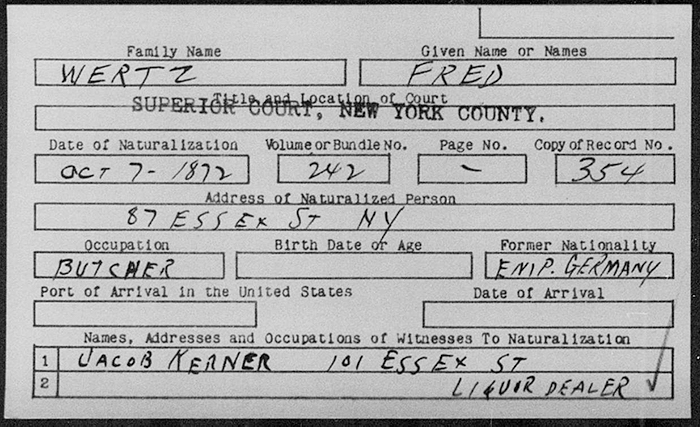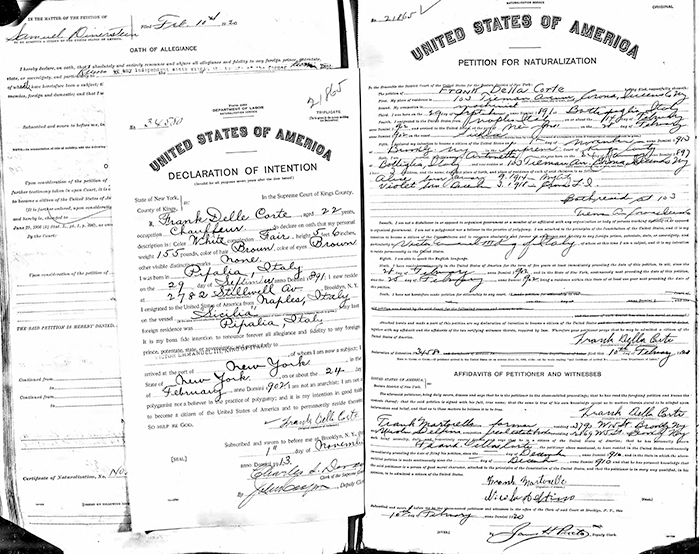Naturalization records document the process our immigrant ancestors went through to become a United States citizen.
For some of our ancestors, becoming a U.S. citizen was a long-sought goal, and there is no better way to preserve this achievement forever than finding the documents that formalized it.
Naturalization records can, depending on the circumstances, also provide an incredible amount of crucial information for the family history researcher, including details about their origins.
Both of these reasons make naturalization records must-have documents. This guide will detail what you need to know about naturalization at different times in history, review several essential strategies for records, and point you to the most important online records.
Before diving in, it's important to note that naturalization was not a process open to everyone throughout American history.
Important Note: Derivative Citizenship
The vast majority of people who underwent the naturalization process were adult men. Though women and children often became citizens through what is called derivative citizenship, this process rarely generated any records.
For the most part, immigrant children under the age of 18 inherited the citizenship of their father, and until 1929 the only documentation they could use to prove their citizenship was the Certificate of Citizenship of their father. After 1929, anyone who derived citizenship from a parent could apply for their own certificate. Some immigrants who gained citizenship through their parents in the 1800s applied later in life, so researchers may want to explore this possibility.
Naturalization for women can be significantly more complicated. Researchers should keep in mind that, in general, there was little motivation for a woman to become a full-fledged citizen due to the severe societal limitations on her freedom. Some did, however, naturalize and generate records. Many derived citizenship from their husbands. Researchers looking specifically for naturalization records of women should read Marian L. Smith's comprehensive article in the National Archives magazine Prologue, Women and Naturalization, ca. 1802 - 1940.
Finding Naturalized Ancestors
A necessary first step is to determine which ancestors were naturalized in the first place, and when they went through the process. Fortunately, this type of research question can be fairly straightforward to answer.
Census records are some of the most accessible documents that can be used. Most censuses will contain each person’s birthplace—those born in foreign countries are obvious candidates for naturalization.
Federal censuses from 1850 onward will contain the birthplace of all household members. Federal censuses from 1890 on will contain the year of immigration and citizenship status. The 1920 census identifies the exact year of naturalization.
New York state censuses are helpful as well: The 1855 New York state census contains birthplace and length of residence in their current municipality. The 1905, 1915, and 1925 state censuses contain birthplace, citizenship status, and number of years in the United States.
Other records will contain this information as well. However you accomplish it, the first goal is to form a hypothesis about when your ancestor may have gone through the naturalization process, and where they lived at the time.
Remember, not all immigrant ancestors got naturalized. There were many reasons—including time, expense, or even allegiance to their native county—that your ancestor may not have become a citizen.
Naturalization Records by Period
The naturalization process has evolved throughout U.S. history and has therefore yielded different records at different times.
As with other types of records, an essential step for all researchers is to learn about the naturalization process at the time of the ancestor you’re researching.
Pre-United States Naturalization in New York
1609–1664: Dutch Colonial New York
Since the colony was operated by the Dutch, immigrants arriving in New Netherland had to take an oath of allegiance to the Dutch parliament, the States General, and to the Dutch West India Company.
Researchers interested in records specifically related to the above process should consult the Colonial chapter of the New York Family History Research Guide and Gazetteer. For general resources for those who immigrated to the Dutch colony, there are online passenger lists available. See our guide to immigration records for a list of resources related to colonial passenger lists.
1664–1776: British Colonial New York
Immigrants arriving in New York after 1664 had to take an oath of allegiance to the King of England in order to enjoy the privileges afforded to his subjects, including the right to own land. Naturalization was expensive, but a more affordable process known as denization also allowed for land ownership. Both processes required action in England, until 1740 when Parliament allowed the colonial government to naturalize aliens.
The first place to check for naturalization records (and an excellent detailed overview of the process) is Kenneth Scott and Ken Stryker-Rodda’s Denizations, Naturalizations, and Oaths of Allegiance in Colonial New York, available to search and read online on Ancestry.com. Other print sources exist, see the New York Family History Research Guide and Gazetteer.
Naturalization in New York, 1776–1790
During the Revolution, both sides required and often demanded oaths of allegiance. By 1783, all current residents of New York State became U.S. citizens.
Before 1790, U.S. naturalizations in New York were done via acts in the state legislature. The written records don’t provide too much more than names and dates:

Many New York early naturalization records from before 1790 can be found in the Laws of the State of New York, which are available to search and browse online for free.
- Laws of the State of New York, vol. 1 1777-1784
- Laws of the State of New York, vol. 2 1785-1788
- Laws of the State of New York, vol. 3 1789-1796
For most of U.S. history, naturalization was a two-step process. The immigrant would file an initial form, the declaration of intention (often called "first papers"), and then wait for a period of time (usually five years). After the mandatory waiting period, they would file their actual petition for naturalization.
Naturalization in New York, 1790–1906
In 1790, the first federal naturalization act was passed—it allowed naturalization to occur at any court of record (town, city, county, state, or federal) with a clerk and a seal. Though the exact period of time changed several times, after 1802 all aliens were not eligible for naturalization until living in the United States for five years.
For most of U.S. history, naturalization was a two-step process. The immigrant would file an initial form, the declaration of intention (often called "first papers"), and then wait for a period of time (usually five years). After the mandatory waiting period, they would file their actual petition for naturalization.
Between 1790 and 1906, either of these steps could occur at any court of record, and both did not have to take place at the same court.
This means researchers will find naturalization records at a wide variety of courts. In New York State, county governments are the primary repositories of records for this time period, so research into available naturalization records should be done at the county level. The best approach is to determine where your ancestor likely lived when they became naturalized, and research naturalization in that specific county.
Our County Guides for Family Historians provide overviews of naturalization and all other records for each county in New York State.

FamilySearch has a large collection of county naturalization records: New York, County Naturalization Records, 1791-1980. Coverage for some counties begins as early as 1790, but most start in the 1800s or 1900s. We recommend clicking the link to browse through all of the images—this is a good way to get an overview of the holdings for each county, which will be listed in the image browse menu.
The records for most naturalizations that took place in New York federal courts are held by the National Archives and Records Administration branch in New York City. These can be accessed in-person, but are also available on Ancestry.com to paying subscribers. See New York, State and Federal Naturalization Records, 1794-1943 and New York, Index to Petitions for Naturalization filed in New York City, 1792-1989.
Keep in mind that your ancestor could have filed their “first papers” in one location, moved over the course of five years, and complete their petition for naturalization somewhere else. There was no requirement to file for both steps at the same court.
Naturalization in New York After 1906
According to the New York Family History Research Guide and Gazetteer,
"The great wave of immigration in the late nineteenth century led to a substantial increase in the number of people who sought to become citizens. This created a breeding ground for fraud and widespread corruption, which came to the attention of the federal government. Major legislation passed in 1906 created the federal Naturalization Service to standardize fees, forms, and procedures; the Bureau of Immigration became the Bureau of Immigration and Naturalization."
After 1906, naturalization could still happen in nonfederal courts, but these courts were required to collect a certain level of information—usually far more than what is found in naturalization documents before 1906:

Courts retained original copies but had to send duplicates to the Bureau of Immigration and Naturalization in Washington, DC, where it was added to a record called a C-file.
In 1933 the Immigration and Naturalization Service was formed and processed most naturalizations occurring in New York.
The Bureau of Immigration and Naturalization maintains “C-files” for naturalizations between 1906 and 1956 – generally, these files contain the most genealogically relevant information of all naturalization records. The records for most naturalizations that took place in New York federal courts are held by NARA-NYC in New York City, and many are available online at Ancestry.com. See New York, State and Federal Naturalization Records, 1794-1943 and New York, Index to Petitions for Naturalization filed in New York City, 1792-1989
Researchers can visit the genealogy section of the USCIS website for an index search program that can help locate the C-file number.